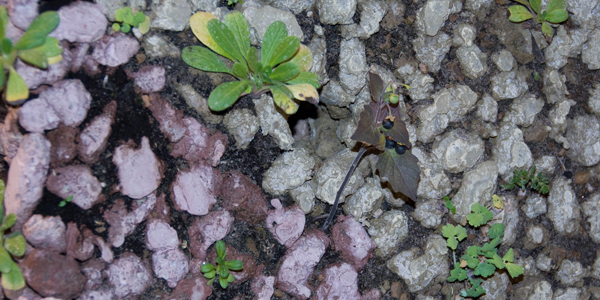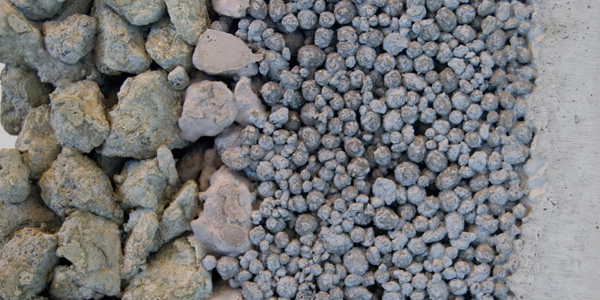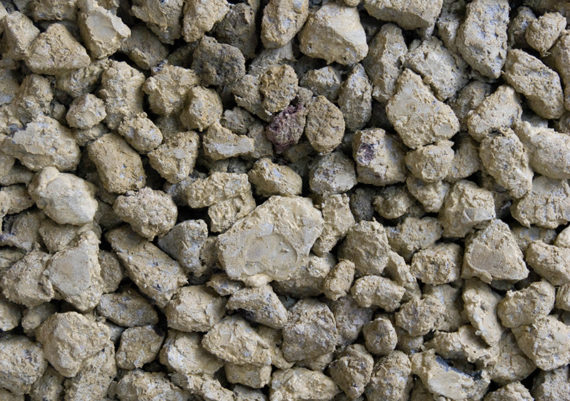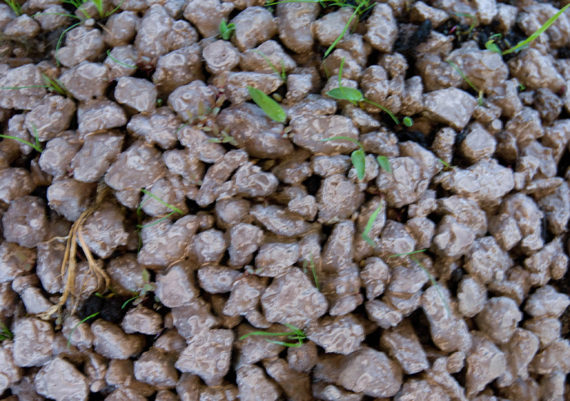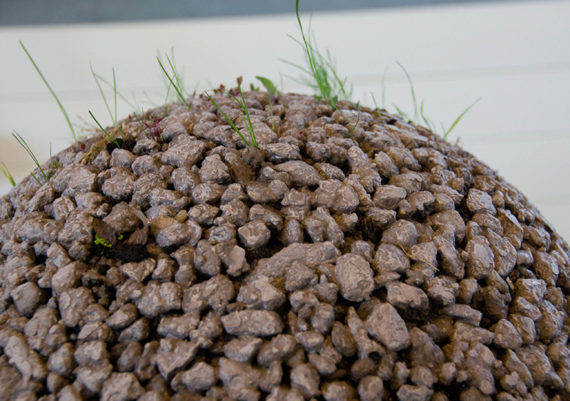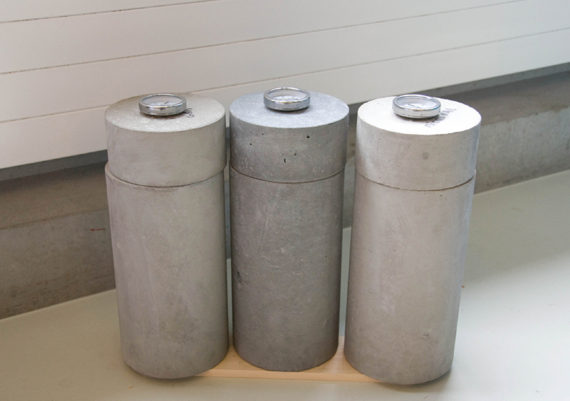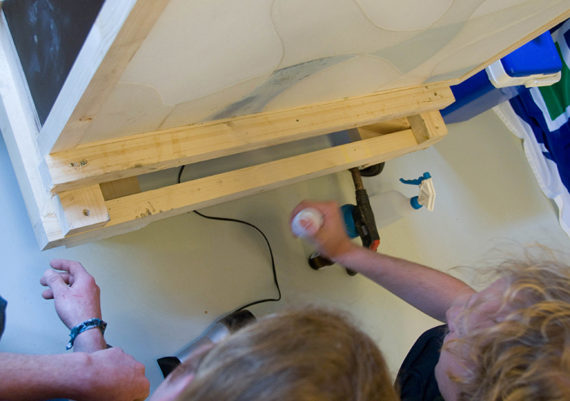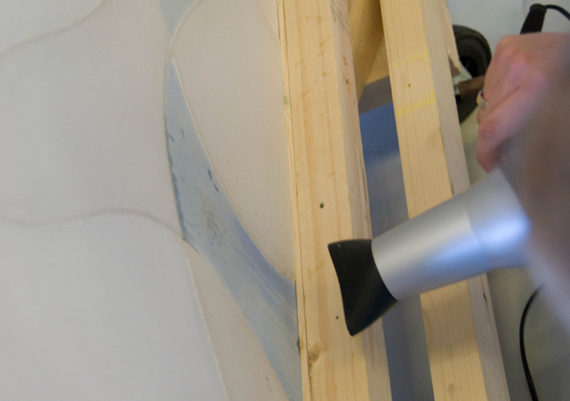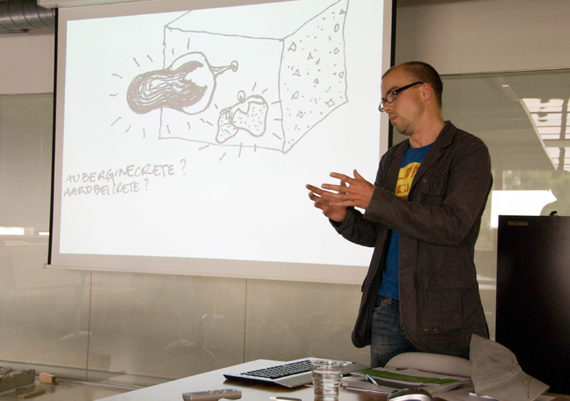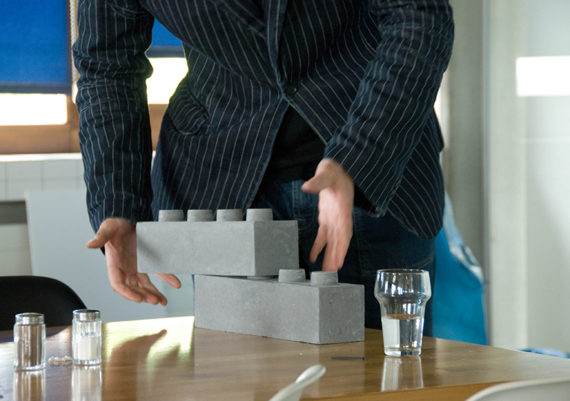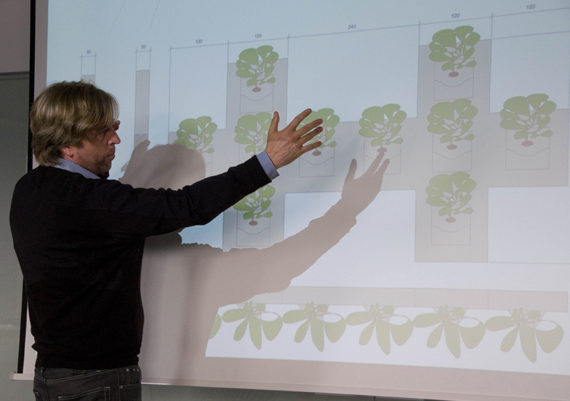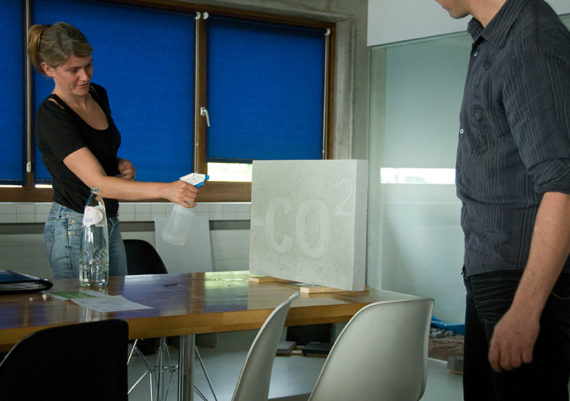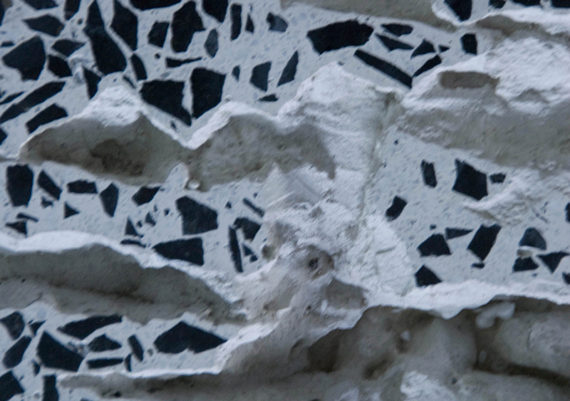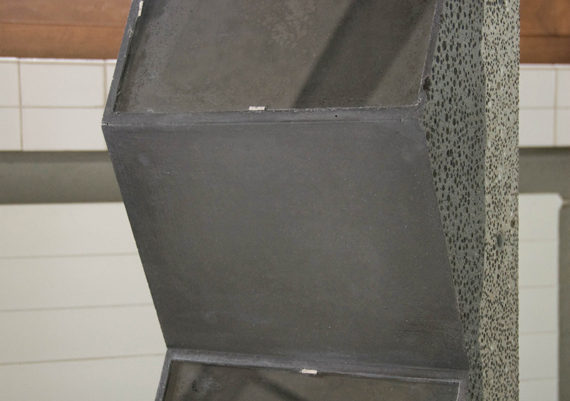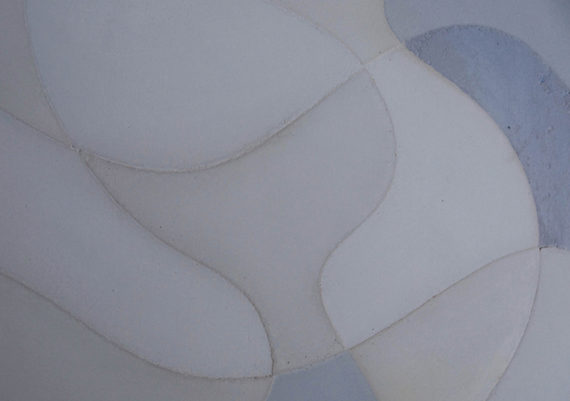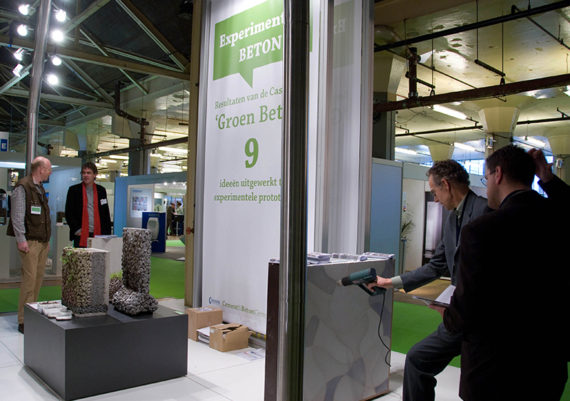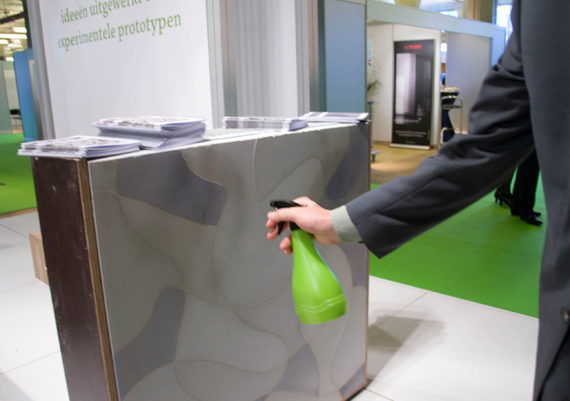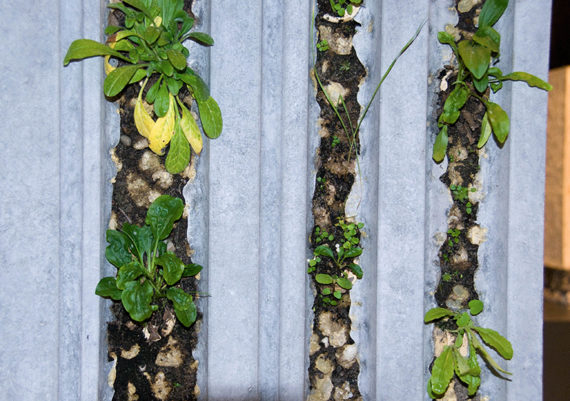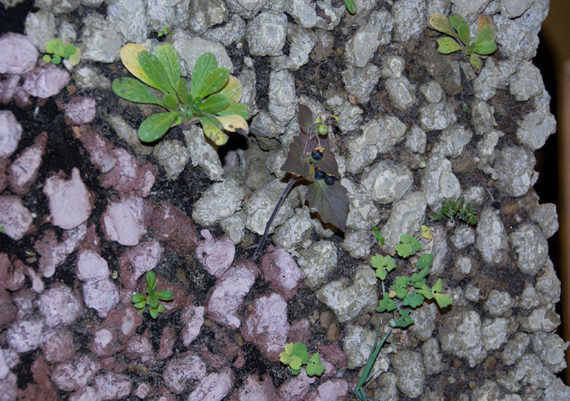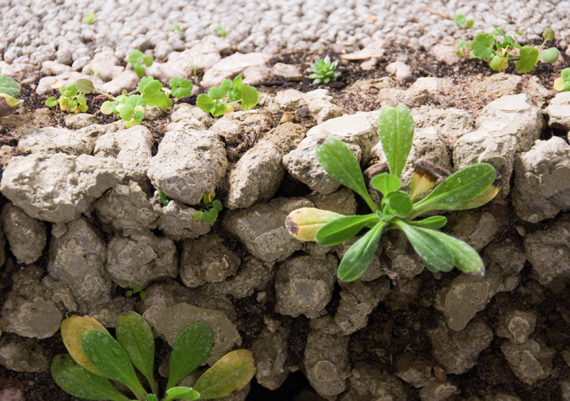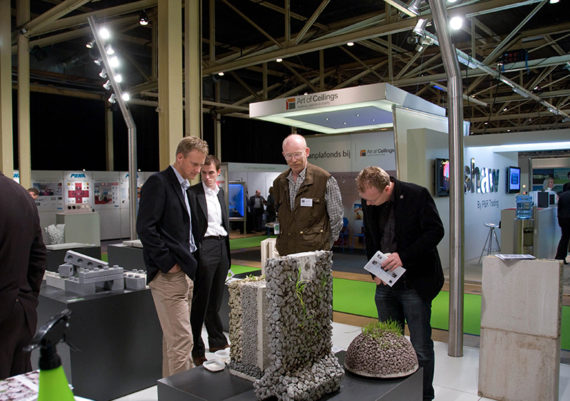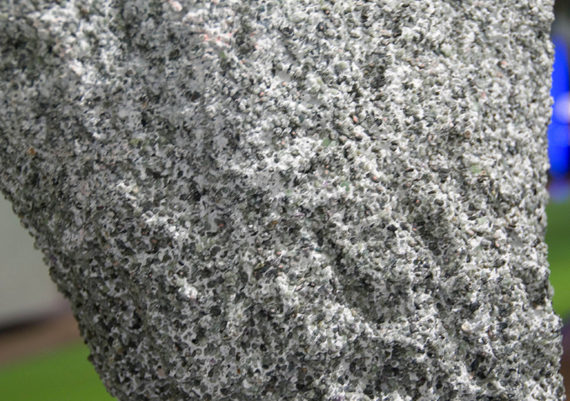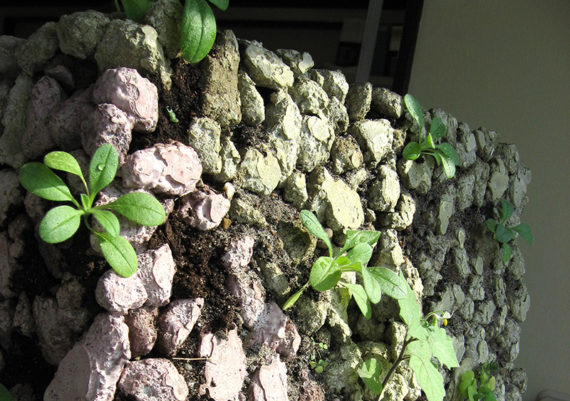prefab concrete casestudy 6 green concrete
One-day brainstorm session with designers, prefab concrete producers and experts leads to inventory of ambitions and understanding of each others disciplines. No idea is too outrageous, all ideas are seriously approached and developed, money and technique have to follow proposals for new concrete applications. After which prototypes are produced to test the ideas.
2008
concept, coordination & management, moderating, publication
what you always wanted to do in concrete...
Always wanted to know how to control corrosion of surfaces? And how to keep them aesthetical intriguing? Are there samples in architecture or art that keep puzzling you in terms of how they were created? Want to know if it is possible to generate formal or tactile ‘chance’ within a serial production method? Want to understand and manipulate existing production techniques and methods to push the envelope of the possible? Just having an outrageous idea? That you like to get tested for practical and economical feasibility?
Unanswered questions, extreme applications and seemingly impossible ideas form the starting point of these Casestudies. How to realise ever further reaching fascinations and ambitions of architects and designers is the core of this initiative.
These are Casestudies since ideas are not only examined and explored with professional support, they are actually manufactured in order to really test their merits. Specialists from various producing industries as well as engineers and research experts have worked in one-day intense brainstorm sessions in which proposals have been developed into effective descriptions for generating the prototypes. The collaborating industry have manufactured these objects under professional conditions in order to be analysed and reviewed.
Groen Beton (NL)
Beton in de architectuur is voornamelijk bekend om enerzijds zijn constructieve eigenschappen en anderzijds om zijn soms bejubelde en vaak verguisde esthetische kwaliteiten. Op beide fronten vinden er ontwikkelingen plaats die voorlopig nog onopgemerkt blijven bij het grote publiek, maar door gedreven ontwerpers en bouwers worden opgepakt. De algemene tendens toont een verdergaande integratie van architectuur, constructie en installaties: beton als integraal en integrerend materiaal. De Casestudies Prefab Beton zijn bedoeld om recente ontwikkelingen te verkennen en nieuwe te stimuleren. In open dialoog tussen ontwerpers en producenten worden nieuwe mogelijkheden verkend en getoetst.
Voorgaande casestudies waren onder andere gericht op licht en beton, de mogelijkheden van vormvrijheid en verscheidenheid, verschillende vormen van ‘levend’ beton en de wens om het verouderingsproces van beton te controleren. Deze zesde casestudy richt zich op ‘groen beton’, een notie die onder andere de twee laatst genoemde thema’s in zich herbergt.
In een tijdsperk waarin begrippen als ‘duurzaamheid’ en ‘CO2- en klimaatneutraal’ op grote schaal naar voren worden gebracht als beslissende factoren voor onze toekomst is het destemeer zaak om genuanceerde, afgewogen en intelligente oplossingen en toepassingen te ontwikkelen.
Het ligt voor de hand om de duurzaamheid en de levensduurcyclus van beton te benadrukken en verder uit te buiten. Een betonnen skelet kan letterlijk eeuwen mee mits er voldoende flexibiliteit is ingebouwd voor uiteenlopende gebruiksprogramma’s die zelf een veel kortere levensduurcyclus blijken te hebben. Actief en passief gebruik van de thermische massa van beton zal een grote rol gaan spelen in het drastisch reduceren van energiegebruik in gebouwen. Daarnaast zijn er interessante vorderingen op het gebied van thermisch isolerend constructief beton.
Voorts blijkt er een latente vraag te bestaan bij ontwerpers en gebruikers naar een ‘echt’ groen beton: beton waarvan het levenloze karakter wordt gecombineerd met begroeiing, al dan niet in de vorm van mossen of planten. Een zoektocht dus naar ‘levende’ gebouwen of minstens gebouwen die een zekere vorm van natuur herbergen in hun architectonische en constructieve opbouw en dan niet slechts middels atria, binnentuinen of fantastische situering. De lange levensduur van beton roept ook op tot verbetering en beheersing van veroudering en verwering. Zo wordt er gewerkt aan zelfreinigend beton, wat de ‘originele’ verschijningsvorm benadrukt, terwijl er ook aandacht nodig is voor verouderingsprocessen die wellicht meer verschijnen als een metamorfose.
Kortom, daar waar ‘groen beton’ op het eerste gezicht een eenvoudige reactie lijkt op de vraag naar eco-producten strekt deze casestudy zich verder uit naar wellicht complementaire toepassingen.
Als laatste voorbeeld van aandacht is ‘groen beton’ ook op te vatten als reactie op de zoektocht naar perfect duurzaam wit of zwart beton. Beide zijn zeker nog niet ‘opgelost’; het perfecte groen staat zeker garant voor een gelijkwaardige uitdaging.
Aan ontwerpers hiermee de vraag zich te buigen over groen en beton, over persoonlijke fascinaties en drijfveren, die niet beperkt hoeven te blijven door de bovengenoemde voorbeelden en richtingen.
In de casestudy worden gezamenlijk de grenzen opgezocht van materiaalsamenstellingen, productieprocessen, toepassingen en gebruik.
prefab concrete casestudies
The initiative for the Prefab Concrete Casestudies originates from striving towards a more intense, exploring and fruitful communication between manufacturers of prefab concrete and designers. The Casestudies are organized in such a way as to focus this communication on the development of the product – prefab concrete. As such an innovative approach of design, application and manufacturing becomes the main issue.
Concrete is often seen as an economic choice. In which en aesthetic less attractive result is taken as unavoidable ingredient. Despite a growing amount of very outspoken and attractive examples, in which concrete explicitly is deployed for its aesthetic properties, most designers are deprived from these ‘Swiss’ and ‘Japanese’ arts. In the experience of many designers and clients, concrete often remains gray, dull and heavy. And most of all it seems to limit the possibilities for designers to ‘mould’ the materials to their needs.
The Prefab Concrete Casestudies are used to bring a wide-ranging group of designers – both from well-known offices with large portfolios as well as from small and starting practices – in dialogue with the industry. A dialogue which does not merely provide information on existing possibilities and introductions to the latest developments, but one in which designers are being asked what they wish to make. Regardless of the existing knowledge of the designers related to technical options their ambitions are brought into discussion. The industry itself is being asked to temporarily discard existing and seemingly implicit limitations with regard to manufacturing and finances. Each question is valid within the Casestudies. Each proposal is treated seriously and professionally. No matter if it concerns the reproduction of an existing and exotic example, a totally new application, a real problem from ones practice or a true challenge to the industry to use concrete seemingly contrary to its ‘natural’ material properties. Each idea is presented, developed and finally transformed into a work-description for manufacturing during two brainstorm sessions.
The first brainstorm session of each Casestudy focuses on the bases and backgrounds of the ideas. Possible existing examples or relevant projects in other materials are discussed in order to develop the idea. Past experiences from designers as well as manufacturers and technicians are used to specify the idea even more. Not so much in order to bring the idea within already accepted solutions. But in order to let the idea mature and in order to be able to deploy possible similar elements from other ideas within the Casestudy as good and efficient as possible. The aim of this first brainstorm session is simple and absolute: how could the proposal of a designer be accomplished? Knowledge and experience regarding limitations in manufacturing or application are used positively to avoid well-known traps and to efficiently find new and different solutions.
During the second brainstorm session the matured and categorized proposals are developed into descriptions for manufacturing. Possible new techniques, aggregates or combinations with other products are identified and distributed amongst the manufacturers with the most appropriate facilities for each prototype. Form and dimensions of the prototypes as well as the ways of manufacturing are tuned to the expectations of the results – how can one best establish a specific prototypes merits – and the capacities of the manufacturers.
After production an evaluation follows in which the prototypes are reviewed. Are the expectations met? Did any new ideas surface during manufacturing and were they used? Are designers and producers strengthened in their ambitions? And are the first results reason for a continuation of the research?
The Casestudies are seemingly focused on research and development of concrete. The invitation to the designers seems to be very clear about that. Even more than pure product development the Casestudies are foremost an introduction into different cultures. Those of designers and manufacturers. De proposals are often so extreme that within the very short time span of a Casestudy there can only be a first and extremely important step towards a serious product innovation. Nevertheless promising prototypes are being further researched and developed.
The core of the Prefab Concrete Casestudies as presented by the initiators is to discover each others fascinations, ambitions and potential. The potential of concrete. The fascinations for the material by designers as well as the industry. And the ambitions for aesthetics, manufacturing and innovation.
Stan Aarts - MKA architecten - Roosendaal, Xaveer Claerhout - Architectenbureau Claerhout - Van Biervliet - Damme, Mathijs Cremers - bureau SLA - Amsterdam, Mick van Essen - bureau SLA - Amsterdam, Jochem Heijmans - Bureau Jochem Heijmans - Eindhoven, Nadja van Houten - Bureau Bouwtechniek - Antwerpen, Victor de Leeuw - EGM architecten - Dordrecht, Gonçalo Moreira - bureau SLA - Amsterdam, Armand Paardekooper Overman - OIII architecten - Amsterdam, Björn van Rheenen - SPONGE architects - Amsterdam, Edo Schrijver - Rudy Uytenhaak architecten - Amsterdam, Caspar Smeets - EGM architecten - Dordrecht, Tirza Verrips - Studio Verrips - Apeldoorn
concrete experts & participating industry
Gerard Brood - Hurks Oosthoek Kemper, Peter de Caluwé - Decomo, Philippe Courcelles - Decomo, Steven Gelderman - Betonindustrie de Veluwe, Kurt Bertels - Verheyen Beton, Steffen Grünewald - Hurks Beton, Boudewijn De Nys - Prefadim Belgium, Thijs Pingen - Geelen Beton, Wim Rongen - Geelen Beton, Gert Westerink - Betonindustrie de Veluwe
experts
Ine ter Borch - de Architect, Michiel Haas - Nibe, Bert Huls - ontwerpstudio Bert Huls, Marc Ottelé - TU Delft / CiTG, Simon Postmus - Scholz Benelux
moderators
Jef Apers, Siebe Bakker, Hans Köhne
prototypes
cradle2cradle - Geelen Beton with Caspar Smeets, Simon Postmus
growcrete - Betonindustrie de Veluwe with Mathijs Cremers, Gonçalo Moreira, Tirza
Verrips
interactive - Verheyen Beton with Nadja van Houten, Armand Paardekooper Overman, Björn van Rheenen
modular - Prefadim Belgium with Stan Aarts, Hans Köhne, Boudewijn de Nys
olivine concrete - Geelen Beton with Mick van Essen, Thijs Pingen
plant-in-concrete - Prefadim Belgium with Xaveer Claerhout, Boudewijn De Nys
thermocrete - Decomo with Victor de Leeuw, Caspar Smeets
thincrete - Hurks Oosthoek Kemper with Victor de Leeuw
totalconcrete 2.0 - Hurks Beton with Jochem Heijmans
photography
bureaubakker
Marcel van Kerckhoven
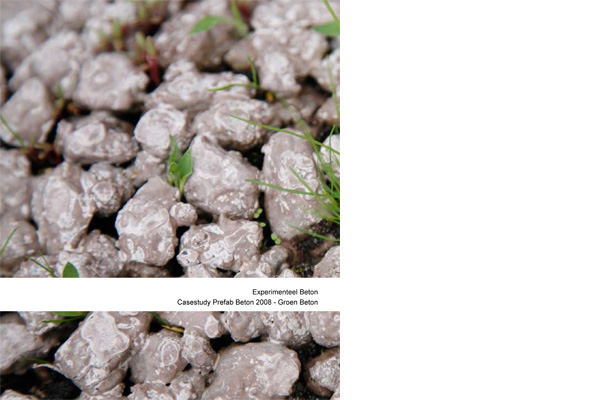
experimenteel beton - Groen beton
2008 / Dutch
Documentation on the 6th Prefab Concrete Casestudy.
editor:
Siebe Bakker - bureaubakker
download pdf
introductie (NL)
Beton in de architectuur is voornamelijk bekend om enerzijds zijn constructieve eigenschappen en anderzijds om zijn soms bejubelde en vaak verguisde esthetische kwaliteiten. Op beide fronten vinden er ontwikkelingen plaats die voorlopig nog onopgemerkt blijven bij het grote publiek, maar door gedreven ontwerpers en bouwers worden opgepakt. De algemene tendens toont een verdergaande integratie van architectuur, constructie en installaties: beton als integraal en integrerend materiaal. De Casestudies Prefab Beton zijn bedoeld om recente ontwikkelingen te verkennen en nieuwe te stimuleren. In open dialoog tussen ontwerpers en producenten worden nieuwe mogelijkheden verkend en getoetst.
Voorgaande casestudies waren onder andere gericht op licht en beton, de mogelijkheden van vormvrijheid en verscheidenheid, verschillende vormen van ‘levend’ beton en de wens om het verouderingsproces van beton te controleren. Deze zesde casestudy richt zich op ‘groen beton’, een notie die onder andere de twee laatst genoemde thema’s in zich herbergt.
In een tijdsperk waarin begrippen als ‘duurzaamheid’ en ‘CO2- en klimaatneutraal’ op grote schaal naar voren worden gebracht als beslissende factoren voor onze toekomst is het destemeer zaak om genuanceerde, afgewogen en intelligente oplossingen en toepassingen te ontwikkelen.
Het ligt voor de hand om de duurzaamheid en de levensduurcyclus van beton te benadrukken en verder uit te buiten. Een betonnen skelet kan letterlijk eeuwen mee mits er voldoende flexibiliteit is ingebouwd voor uiteenlopende gebruiksprogramma’s die zelf een veel kortere levensduurcyclus blijken te hebben. Actief en passief gebruik van de thermische massa van beton zal een grote rol gaan spelen in het drastisch reduceren van energiegebruik in gebouwen. Daarnaast zijn er interessante vorderingen op het gebied van thermisch isolerend constructief beton.
Voorts blijkt er een latente vraag te bestaan bij ontwerpers en gebruikers naar een ‘echt’ groen beton: beton waarvan het levenloze karakter wordt gecombineerd met begroeiing, al dan niet in de vorm van mossen of planten. Een zoektocht dus naar ‘levende’ gebouwen of minstens gebouwen die een zekere vorm van natuur herbergen in hun architectonische en constructieve opbouw en dan niet slechts middels atria, binnentuinen of fantastische situering. De lange levensduur van beton roept ook op tot verbetering en beheersing van veroudering en verwering. Zo wordt er gewerkt aan zelfreinigend beton, wat de ‘originele’ verschijningsvorm benadrukt, terwijl er ook aandacht nodig is voor verouderingsprocessen die wellicht meer verschijnen als een metamorfose.
Kortom, daar waar ‘groen beton’ op het eerste gezicht een eenvoudige reactie lijkt op de vraag naar eco-producten strekt deze casestudy zich verder uit naar wellicht complementaire toepassingen.
Als laatste voorbeeld van aandacht is ‘groen beton’ ook op te vatten als reactie op de zoektocht naar perfect duurzaam wit of zwart beton. Beide zijn zeker nog niet ‘opgelost’; het perfecte groen staat zeker garant voor een gelijkwaardige uitdaging.
Aan ontwerpers hiermee de vraag zich te buigen over groen en beton, over persoonlijke fascinaties en drijfveren, die niet beperkt hoeven te blijven door de bovengenoemde voorbeelden en richtingen.
In de casestudy worden gezamenlijk de grenzen opgezocht van materiaalsamenstellingen, productieprocessen, toepassingen en gebruik.

Experimenteel Beton - Casestudies Prefab Beton 2003 - 2008
2009 / Dutch
Documentation on the first six Prefab Concrete Casestudies. On the occasion of winning the Dutch Building Award 2009 for the Prefab Concrete Casestudy initiative and format.
editor:
Siebe Bakker - bureaubakker
download pdf
what you always wanted to do in concrete...
Always wanted to know how to control corrosion of surfaces? And how to keep them aesthetical intriguing? Are there samples in architecture or art that keep puzzling you in terms of how they were created? Want to know if it is possible to generate formal or tactile ‘chance’ within a serial production method? Want to understand and manipulate existing production techniques and methods to push the envelope of the possible? Just having an outrageous idea? That you like to get tested for practical and economical feasibility?
Unanswered questions, extreme applications and seemingly impossible ideas form the starting point of these Casestudies. How to realise ever further reaching fascinations and ambitions of architects and designers is the core of this initiative.
These are Casestudies since ideas are not only examined and explored with professional support, they are actually manufactured in order to really test their merits. Specialists from various producing industries as well as engineers and research experts have worked in one-day intense brainstorm sessions in which proposals have been developed into effective descriptions for generating the prototypes. The collaborating industry have manufactured these objects under professional conditions in order to be analysed and reviewed.

